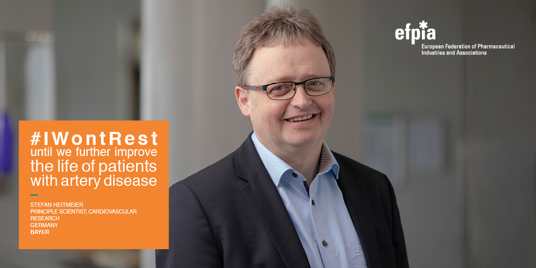I won't rest until we further improve the life of patients with artery disease (Guest blog)
22.07.19
In my training as a pharmacist, I came across many cases of heart attack and peripheral artery disease (PAD) – including some in my own family. Since the turn of the century, we have seen a lot of improvement in the management of vascular disease, like the stenting procedures and dual antiplatelet therapies. However, despite this, vascular disease is still a major burden and remains the #1 cause of death worldwide.
I was very driven to tackle this burden when I was offered the chance to contribute to the science of arterial vessel occlusion as a lab- and project head in Bayer’s Cardiovascular Research Institute 15 years ago.
In most arterial vessel occlusions, clots made of activated platelets and fibrin are what obstruct the blood flow. So, blocking platelet activation and fibrin formation seem to be the logical way to prevent serious events, such as heart attack and stroke. However, since both of these processes are also important for bleeding control, it is important to find the balance between optimized clot prevention and manageable bleeding risk. This is especially true when attempting to balance inhibition of both - the so-called fibrin formation and the platelet activation.

I am excited by the potential for anticoagulants to have additive or even synergistic effects when used together with antiplatelet drugs. Effective prevention of clots may be achieved at low doses when combined with antiplatelet drugs, while minimizing the bleeding risk. In a recent study in people with chronic coronary artery disease (CAD) or PAD, the combination of an antiplatelet and a low-dose anticoagulant succeeded in reducing major vascular events and cardiovascular death - even when started years after the first event!

I am excited by the potential for anticoagulants to have additive or even synergistic effects when used together with antiplatelet drugs. Effective prevention of clots may be achieved at low doses when combined with antiplatelet drugs, while minimizing the bleeding risk. In a recent study in people with chronic coronary artery disease (CAD) or PAD, the combination of an antiplatelet and a low-dose anticoagulant succeeded in reducing major vascular events and cardiovascular death - even when started years after the first event!
As a ‘clottologist’, I am happy that anticoagulant and antiplatelet combination therapy – available now in many countries - has been found to significantly contribute to finding a balance between prevention of stroke, heart attack and acute PAD limb events in our high-risk patients, without significantly increasing the risk of the most serious bleedings.
However, for a scientist always new questions arise: Could it be possible that anticoagulants have an effect, not only on the clot, but also on the diseased wall of the vessel? Could vascular protection mechanisms observed in the lab contribute to the beneficial effects? And so on … These questions continue to drive my passion and work as a scientist every day.